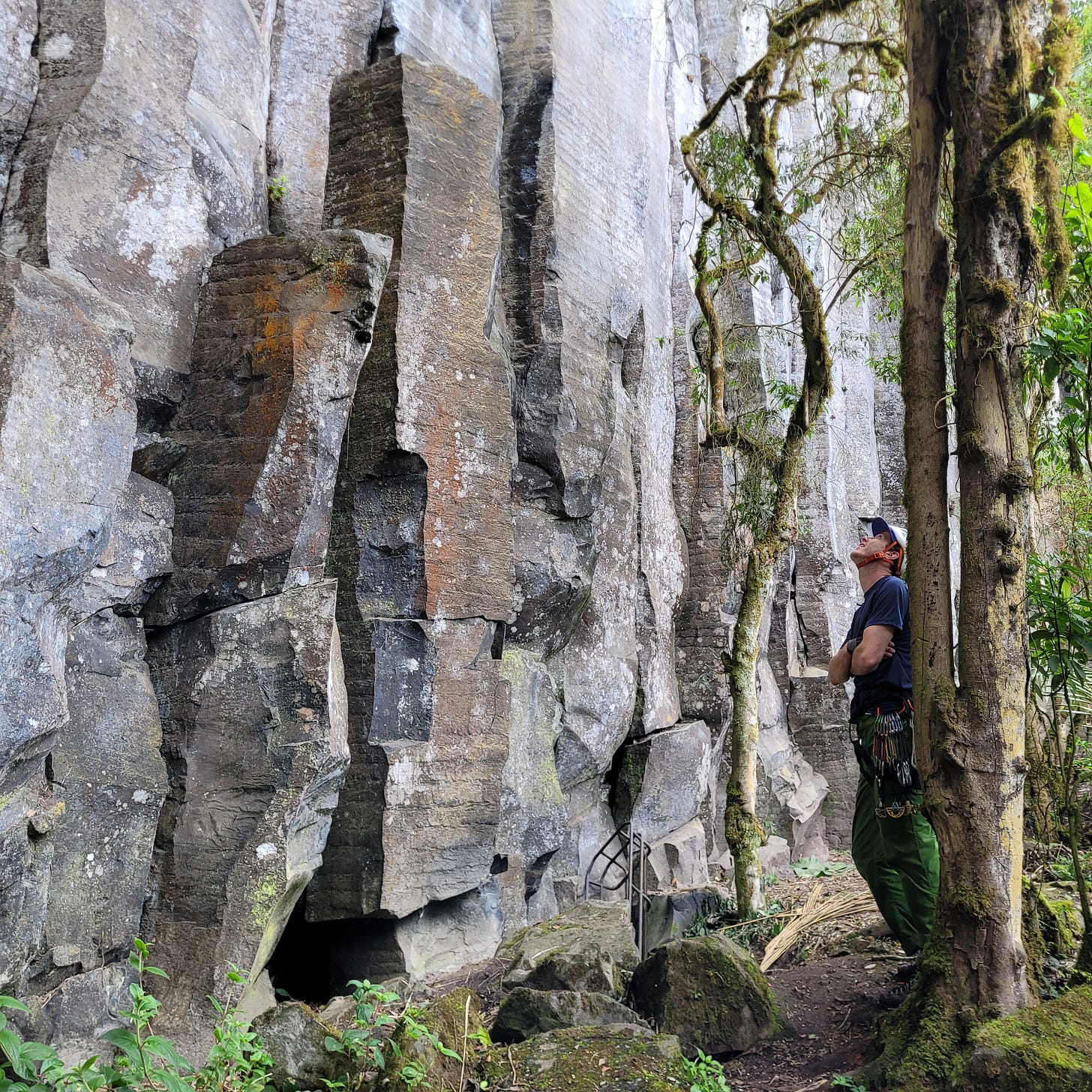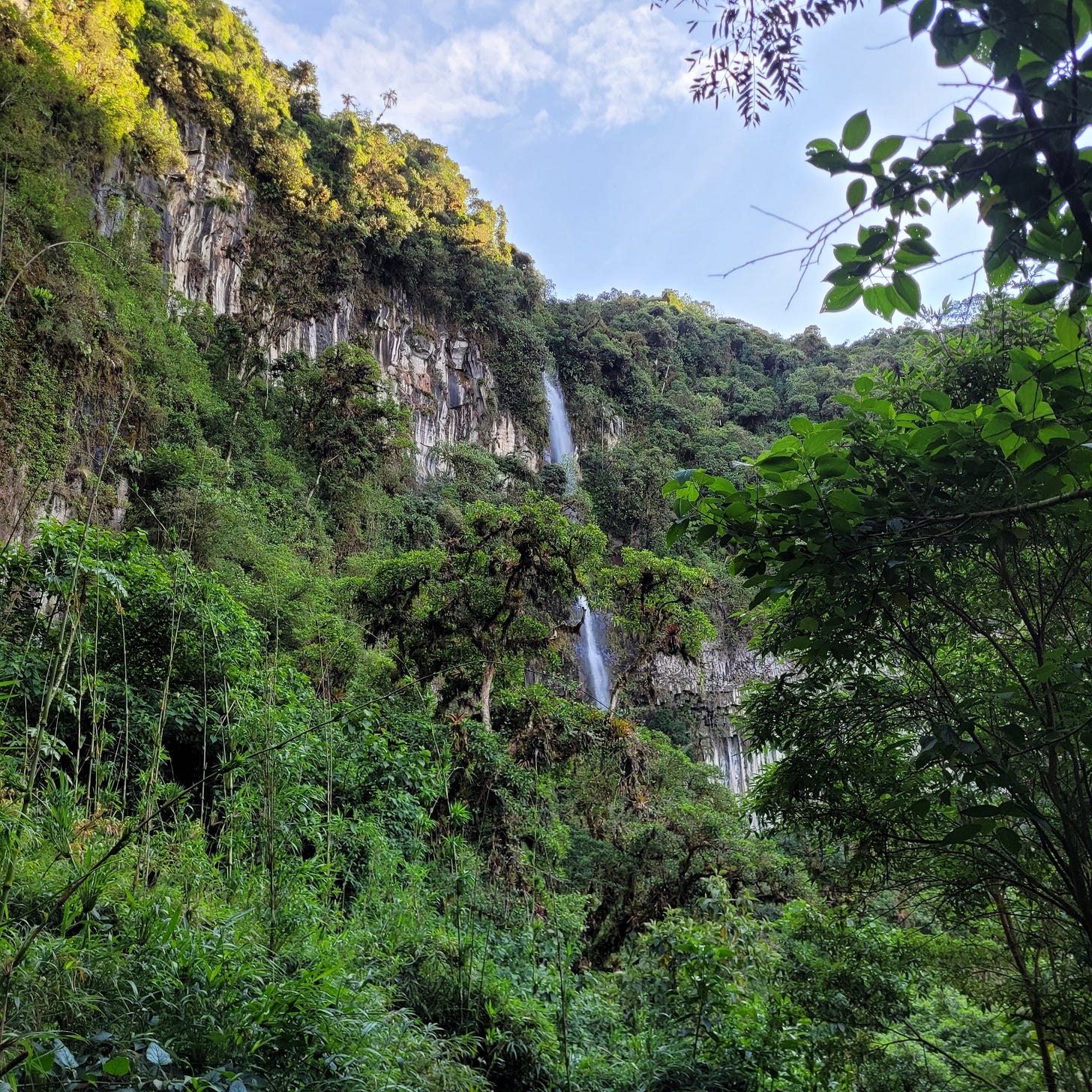Climbing in the Columnas de Tangán
Celebrating New Years with crack climbing, chicha, canela and the community of Cerro Azul
When I started investigating rock climbing destinations in Ecuador, I was immediately drawn to the photos and videos I saw of the Tangán. The gigantic bowl of columnar basalt and the surrounding cloud forest ecosystem looked like something out of Jumanji.
However, during the early stages of my planning, I decided not to consider Tangán as one of our climbing destinations purely out of laziness– I did not want to commit to packing the extra equipment we would need to climb there.
It felt a little over the top to pack extra items like sleeping bags, dehydrated meals, and specific climbing equipment, like a triple rack of cams, only to eventually climb for three days in Tangán.
Luckily, Local Advice Trumps Laziness
All of that changed when I started exchanging emails and text messages with local climbers about the destinations I wanted to travel to and the destinations they thought Whitney and I should climb at.
Essentially, the message was that if we were going to go rock climbing in Ecuador, it would be silly not to visit Tangán, even if we would only have three days to check out the zone. Considering the advice came from one of Ecuador’s most prominent climbing developers and guidebook authors, Whitney and I decided to cancel two nights we had booked elsewhere and replace them with two nights in Tangán.
We could not have made a better decision.
Getting to Tangán was Pretty Involved
After a week of surfing and getting sunburned at the beach, we blasted north from the port city of Guayaquil to Quito. After landing, we rented a car and began a three-hour drive southwest to the Cotopaxi region of Ecuador with the Andean town of Sigchos in our crosshairs.
If everything were going to go to plan, in Sigchos, we would meet up with a driver who could show us a safe place to park our rental car for three days and then transport us an additional hour into the backcountry to Tangán’s trailhead.
Fortunately, our travel process went off without a hitch. After almost five hours of moving, many of which occurred on winding dirt roads akin to an old rollercoaster you are sure will explode at any second, we finally were ready to hump our packs onto our backs and begin the 30-minute hike down into Tangán.

As our driver sped off down the dirt road back towards Sigchos, and the surrounding clouds enveloped us, the increasing sensation of hiking off into the abyss to hopefully find some rocks to climb settled in.
Fortunately, we were not alone.
The Guardian of Tangán
Before we could walk even 100 meters, Don Ramiro Uribe, the local land owner, guardian of Tangán, and all-around nice guy, quite literally appeared out of nowhere through the clouds on horseback (who we later learned was named Colega, which translates to “colleague”). At their feet came the excited barking and incessant tail wagging of his dog, Zapatin.
From the text messages we exchanged before the trip, I could tell that Ramiro would be a good dude. But I was not prepared for how welcoming he actually was. After a couple of handshakes and multiple reminders that we were at home with him in Tangán, we started the descent.
During the hike, I learned that Ramiro has lived in the area his entire life. Over the years, and via familial inheritances, Ramiro has become the owner of hundreds of hectares of the most pristine wilderness I’ve ever set my eyes on. On his land and with his wife, he raises cows for milk, grows food, and facilitates climbing tourism to his beloved Columnas de Tangán.
Tangán Has Ancient Spiritual Roots
Before climbing, Tangán was a place of intense spiritual worship. Ramiro knows this because when he first started exploring the extent of his land, he found ancient artifacts from Incan and pre-Incan cultures (he had them carbon-dated by Quiteño archeologists). Amongst these artifacts were two headless skeletons, remnants of ancient human sacrifice, a common practice believed to please the gods.
To this day, Ramiro still allows visitors to facilitate ancestral and medicinal ceremonies at various sacred sites scattered throughout the Tangán region. But perhaps more frequent than ayahuasca ceremonies are dirtbag climbers coming to sample some of the most splitter crack climbing Ecuador (and maybe South America) has to offer.
Developing the Climbing at Columnas de Tangán
The transition to rock climbing didn’t occur until 2018. At the time, local climbers Felipe Praoño and Steve “El Gringo” Lozano sought out the columns in search of splitter crack climbing that basalt columns typically offer (Whitney and I experienced columnar basalt crack climbing for the first time in Smith Rock, Oregon). Before even meeting Ramiro, they were developing routes.
Fortunately for them, and climbers like Whitney and me, when they finally met Ramiro, he agreed to allow them to continue developing on one condition– that he be involved to continue his stewardship of Tangán and benefit from the climbing tourism that inevitably would come.
In the subsequent years, bomber anchors were installed, approach trails were developed, pit toilets were dug, cabanas for climbers to stay in were built, and a donkey named Socio (which translates to “associate”) was bought for Ramiro to help porter equipment and lessen the load on Colega.
Little by little, a sustainable relationship between Ramiro, rock climbers, and the wilderness of Tangán was developed. One which Whitney and I got to experience for three of the muddiest, most beautiful climbing days of my life.
Mud on the Ground and Cracks in the Wall
Our arrival to Tangán (and Ecuador more generally) was timed almost perfectly with the onset of the el niño phenomenon. That meant that mornings were mostly dry and beautiful, but afternoons were almost always rainy. Therefore, every morning, we were up early and outside.
It was the same for our mornings in Tangán. Then, inevitably, afternoons in Tangán became utterly whited out with thick clouds. It was like hiking, climbing, and living inside a ping-pong ball.
Due to the rains, any amount of dirt on the ground was now mud. In hindsight, we were clued into this reality by Ramiro's bright yellow waterproof rain boots, which he donned daily. Meanwhile, mine and Whitney’s feet became like pruned mud raisons.
However, miraculously, the rock stayed completely dry due to the dense vegetation of orchids, trees, and air plants hovering over the cliff like a royal Andean crown. This meant that despite the rain, Whitney and I could jam our twenty digits and four limbs into cracks until we were utterly exhausted and pumped.
Due to the nature of the cliff, the climbing in Tangán consisted mostly of crack climbing. There were cracks from tips and fingers to burly offwidths. There was also tons of powerful laybacking, technical stemming in dihedrals, airy bottomless stem boxes, and the occasional face hold.
The cliff was steep– almost perfectly vertical in most places and sometimes slightly overhanging. This meant that every climb was sustained and physical. The easiest climb was 5.9, of which there was one and where we warmed p everyday, and the majority was 5.10 and 5.11. There are even heinous-looking tips cracks, and seams that go at 5.13. The proudest lines were between 20 and 30 meters long.


The Culture Was as Good as the Climbing
When Whitney and I rearranged our trip to include Tangán, it meant we had to accept that we would be spending New Years Eve “alone” in the middle of “nowhere” and with no means for our “normal” celebrations like family, friends, music, beers, cocktails, fireworks and whatever else.
The climbers in us knew that would be okay because we would be climbing instead. Plus, we don’t actually party that much. However, the lingering social sides of our personalities wanted to experience what New Year festivities would be like in Ecuador.
Fortunately for both of us, we got the best of both worlds.
On the morning of day two, Ramiro invited us to accompany him to the local New Year's Eve celebration in a small town called Cerro Azul. He explained that he would arrange a truck to take us to and from the party and invited us to stay in his spare bedroom so we wouldn’t have to hike back down to our cabana in Tangán after dark.
So at about five o'clock, in anticipation of the party, we stopped climbing, made a couple of coffees, ate a snack, and hiked up to Ramiro’s home on the rim of Tangán. There, we met his wife Marianna and a farmhand named Stalin. Marianna invited us to enjoy a cup of fresh milk from their cows, dosed with panela (sugar from sugar cane). Neither Whitney nor I had had a straight cow’s milk in quite some time, but we were glad we did; it was delicious.
Shortly after our dairy-infused pre-game was over, a truck arrived to take us down to Cerro Azul. By seven o'clock, we had been introduced to and shook hands with everyone at the party. By 7:30, we were dancing to Ecuadorian chicha music, which was super reminiscent of the huaynos I danced to when I lived in Peru.
By 8 o’clock, we were promptly tuckered out and skeptical of our decision to stay out until midnight to celebrate New Year’s. So to keep the engines running and well lubricated we imbibed pilsner beers with new friends and sipped on a drink called canela– a warm sugar and spice infused drink spiked heavily with sugar cane liquor.
Before we knew it, midnight was just around the corner. Local community leaders shared short speeches, including Don Ramiro, who was making his official invitation to next year's party, where he would be the host.
Meanwhile, the Viejo began to get paraded around. The Viejo, also known as año viejo, is a life-sized stuffed figurine. It’s meant to look like the host of the current New Year’s party and symbolize all the crap, misfortune, and drama that came with the old year. To purge the old and prepare for the new, the Viejo is ignited at midnight, whereby all the said crap, misfortune, and drama is incinerated, wafting off into the starry skies.
With the old year properly purged and Whitney and I’s energy levels absolutely depleted, we enjoyed a few more drinks and exchanged hugs and handshakes with community members, wishing them a happy new year.



Finally, it came time to load up the truck and drive back up the road to Ramiro’s home in Tangán. Additional neighbors loaded into the back to take advantage of the free ride and additional bottles of canela were purchased to keep the party invigorated throughout the drive. With singing and drinking passengers in the back of the party-truck and Whitney and I nodding off asleep in the front of the truck, we bumped and bounced our way back home.
Sometime barely before three o’clock in the morning, we finally got to lay down in bed. Four some-odd hours later, awoken by the rising sun and an absolutely over-stoked rooster directly outside our bedroom window, Whitney and I hiked back down to the Columnas of Tangán for one more day of phenomenal climbing.






